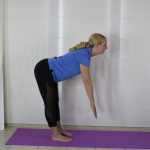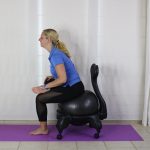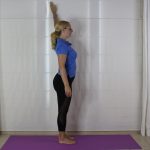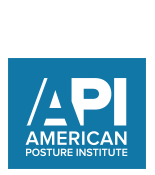
4 Posture Stretches to Prevent Back Pain
If you are seated all day, these stretches are for you. If you have back pain, these stretches are for you. And if you have noticed that it’s hard to sit up straight for more than 20 minutes at a time, these stretches are for you!
Whether your goal is to prevent back pain, gain flexibility, or improve your posture, these four stretches are a must do. You don’t need any equipment to perform them, meaning you can perform these exercises while at the gym, when you wake up in the morning, or in your office at work.
These stretches are recommended by Posture Experts worldwide because they help prevent Postural Collapse. The most common muscle groups that present with stiffness and tightness for patients with poor posture are the hamstrings, gluteals, iliopsoas, and the pectoral musculature. By lengthening these muscle groups it helps improve mobility and prevent Postural Collapse of the spine.
What is Postural Collapse?
Postural Collapse is when your body flexes forward towards the ground in response to the force of gravity. For example, while sitting at your desk, instead of sitting up straight, you notice that your shoulders round forward, your head is down, and your back is rounded. This is Postural Collapse.
Another very common example of Postural Collapse is your posture while looking down at your cellphone. Instead of bringing the phone to eyelevel to maintain proper upright posture, you notice that your head flexes forward, your shoulders round forward, and your back has a C-shaped curvature. This is Postural Collapse.
Postural Fitness is the opposite of Postural Collapse. With good Postural Fitness you are able to maintain proper posture while static (sitting at your desk) and while moving (taking a brisk walk outdoors).
When your posture muscles are tight, Postural Collapse is common. To build Postural Fitness and to prevent postural decline implement these 4 Posture Stretches into your daily routine. Lengthening these muscles will help you maintain proper posture and prevent common symptoms associated with back pain.
4 Posture Stretches to Prevent Back Pain
1) Iliopsoas Stretch:
You iliopsoas is an important posture muscle that connects your lower back and your hips to your leg. It is common to feel pain in the front of your leg (at the crease where your hip and leg come together) after being seated for a long period of time. You may even feel pain when  going from a sitting position to a standing position.
going from a sitting position to a standing position.
To perform the iliopsoas stretch, you can be kneeling or standing (as pictured). Bring one leg forward with both hips pointed forward. The knee that is forward should be aligned over your ankle. If your left leg is forward, you will feel the stretch in the front part of your right hip. Bring your arms out to the sides or above your head and hold the stretch for 30 seconds.
Expert Tip: To maintain proper posture avoid shifting your weight forward where your knee goes forward in relation to your ankle.
2) Hamstring Stretch:
It is very common to feel tight hamstrings, meaning the back of your legs feel tight when you bend forward as if to touch the ground. To  perform the hamstring stretch always keep your back straight and prevent collapsing of your torso. Keep your legs straight, but don’t lock them. Bend your hips forward with your back straight and head up to the point of feeling a good stretch in the back of your legs. Hold that position for 30 seconds to stretch the hamstrings.
perform the hamstring stretch always keep your back straight and prevent collapsing of your torso. Keep your legs straight, but don’t lock them. Bend your hips forward with your back straight and head up to the point of feeling a good stretch in the back of your legs. Hold that position for 30 seconds to stretch the hamstrings.
Expert Tip: Don’t worry about touching the ground with your fingers. It is better to keep your back straight with good posture than to round your spine to touch the floor.
3) Figure Four Stretch:
The Figure Four stretch is to stretch the glutes. While seated in a chair cross one leg over the other (your ankle crosses the other knee). Keep  your back straight and head up and slowly lower your chest toward your legs. When you feel the stretch hold for 30 seconds.
your back straight and head up and slowly lower your chest toward your legs. When you feel the stretch hold for 30 seconds.
Expert Tip: Keep your back straight, don’t collapse forward into flexion. The goal is not to bring your shoulders to your legs, it is to keep your chest up and your shoulders back while lowering your torso.
4) Pectoral Stretch:
For the upper body it is very common that the shoulders round forward when the pectoral muscles are tight. To stretch the pecs you want to  open the chest cavity. Bring one arm up and place it on the wall or in a doorway. Bring your body forward with your arm up and back. Feel the stretch through your upper arm and your pectorals. Hold the position for 30 seconds.
open the chest cavity. Bring one arm up and place it on the wall or in a doorway. Bring your body forward with your arm up and back. Feel the stretch through your upper arm and your pectorals. Hold the position for 30 seconds.
Expert Tip: Keep your head and your chest up. Think of lifting your body against gravity to prevent rounding of the shoulders.
While performing all of these stretches remember to breath deeply and to avoid clenching your jaw. Relax your face muscles and focus on your breathing while lengthening your posture musculature. Always maintain proper posture while performing the recommended exercises.
Performing these 4 Posture Stretches each day can help keep back pain away. Proper posture is fundamental to the prevention of low back pain. Plus they feel great! You will feel like you can stand 2 inches taller after performing these key Posture Stretches.



















